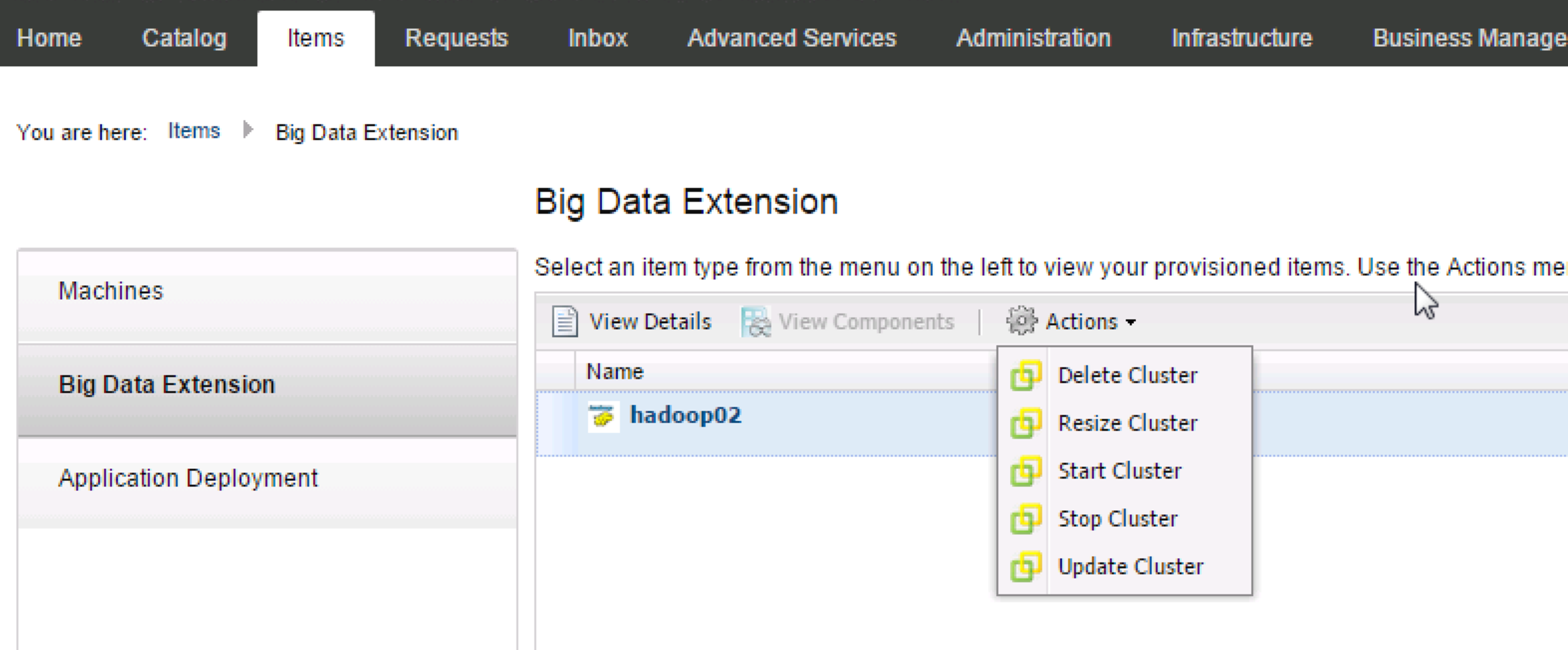What’s New

Enhancements for Large Scale Production Environments
- Optimized for Large Scale Deployment. Big Data Extensions provides improved performance, robustness, and fault tolerance in large scale deployments.
- Multi-Template Virtual Machines.You can configure multiple virtual machine templates and choose which one to use when you create a Big Data cluster. This lets you satisfy customization requirements for different use cases.
- Add New vSphere Resources. You can add additional resource pools and datastores to a running Big Data cluster, letting you easily expand your environment when a Big Data cluster grows beyond multiple vSphere clusters.
- Add New Node Groups. You can expand a running Big Data cluster with new node groups. The node groups can use different virtual machine specifications or roles to satisfy new business requirements.
- Customize Virtual Disks and Controllers. You can control the number of virtual disks per virtual machine in a node group, and specify different virtual disk controller types.
- Recover from Hardware Failures. If you experience disk or server failures you can recover a cluster using the cluster recover command. Big Data Extensions creates new VMDKs or virtual machines from the available resources, and adds them to the cluster.
Big Data Ecosystem Integration
- Support for Spark Clusters. You can easily create a Spark cluster using either the Big Data Extensions GUI or Serengeti Command-line interface.
- Improved HBase Performance. Using new configuration parameters you can create HBase clusters with improved performance.
- Support for the Latest Hadoop Distributions. Big Data Extensions supports Cloudera CDH 5.4 with Cloudera Manager 5.4, Hortonworks HDP 2.3 with Ambari 2.1, Pivotal PHD 3.0 with Ambari 1.7, MapR 5.0, Apache Bigtop 1.0, and Isilon OneFS 7.2.
Big Data Extensions Operations Management
- Improved Upgrade and Restoration. You can export configuration information and data from one Big Data Extensions deployment and import it to another Big Data Extensions deployment. This lets you backup and restore a Hadoop or Hbase instance, or upgrade a new Big Data Extensions instance while retaining all data from the previous version.
- New Linux OS. The Serengeti Management Server and default Hadoop Template virtual machine now use CentOS 6.7.
- Custom sudo Command. You can specify an alternative sudo command when performing OS level configuration with Big Data Extensions. This lets you use root user management tools such as PowerBroker, a centralized application for the authorization and auditing of commands run as the root user. PowerBroker let’s you assign root user privileges to specific users, and authorize and audit their use of the environment.
Download Details:
Download Landing Page
BDE 2.3:
https://my.vmware.com/group/vmware/details?downloadGroup=BDE_230&productId=491&rPId=9646
The following downloads are updated to include BDE 2.3:
- vSphere 6.0: https://my.vmware.com/web/vmware/info/slug/datacenter_cloud_infrastructure/vmware_vsphere/6_0
- vSOM 6.0: https://my.vmware.com/group/vmware/info/slug/datacenter_cloud_infrastructure/vmware_vsphere_with_operations_management/6_0
- vSphere 5.5: https://my.vmware.com/group/vmware/info?slug=datacenter_cloud_infrastructure/vmware_vsphere/5_5
- vSOM 5.5: https://my.vmware.com/group/vmware/info?slug=datacenter_cloud_infrastructure/vmware_vsphere_with_operations_management/5_5
- vSphere 6.0 eval: https://my.vmware.com/group/vmware/evalcenter?p=vsphere6
- vSOM 6.0 eval: https://my.vmware.com/group/vmware/evalcenter?p=vsom


1 Response
[…] vSphere Big Data Extensions 2.3.2 […]